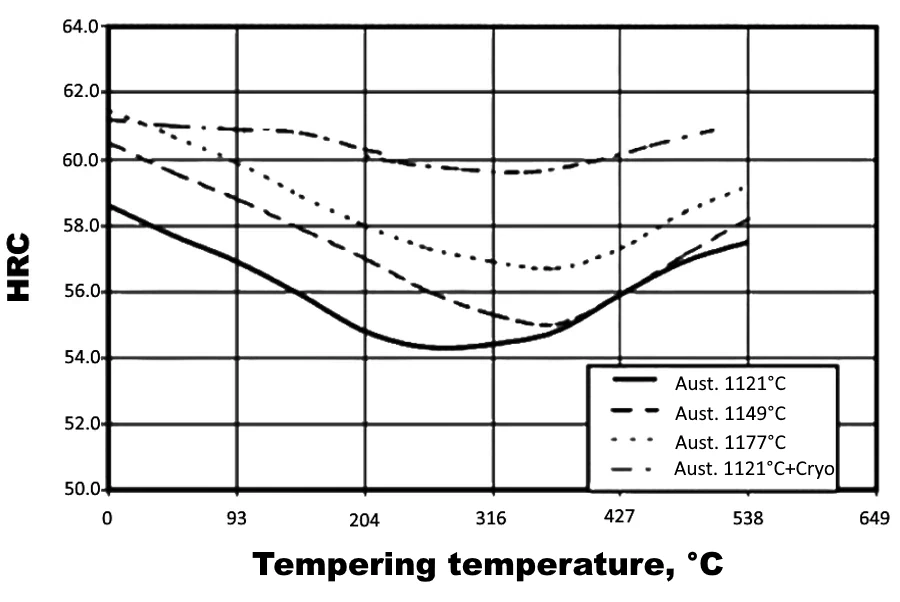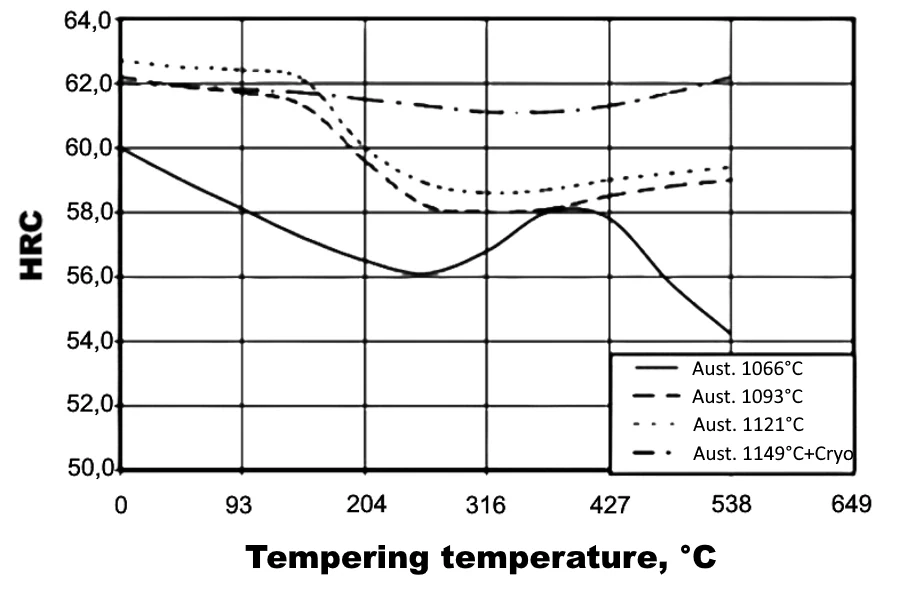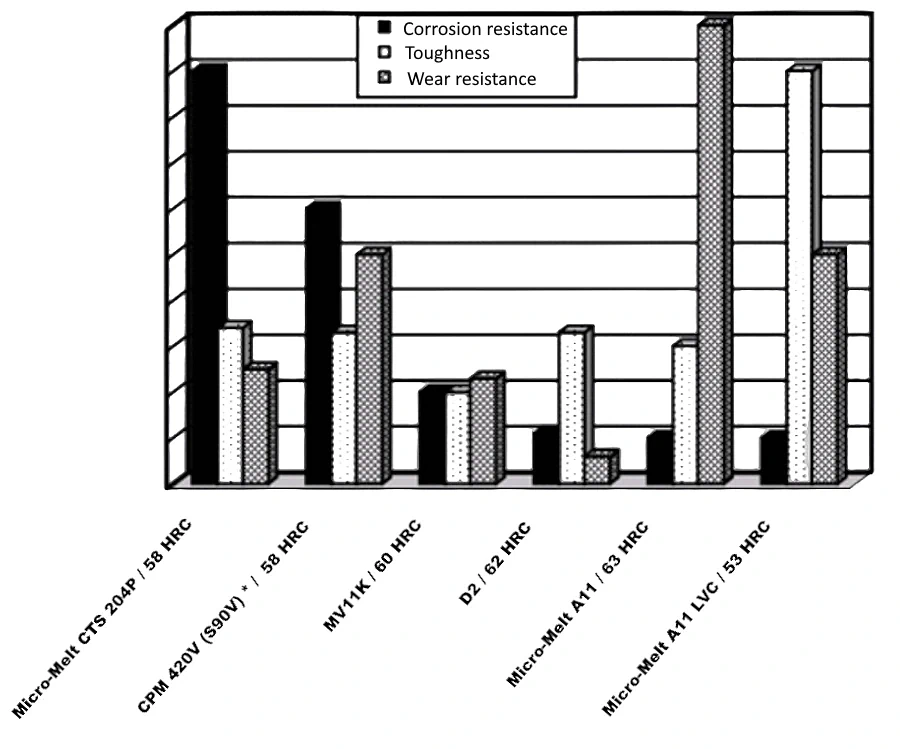CTS 204P is a highly wear-resistant and air-hardenable, corrosion-resistant, martensitic, cold-formed stainless die steel produced using the Micro-Melt powder metallurgy process. The alloy's excellent wear resistance is provided by a significant volume fraction of vanadium-rich hard carbides, while the alloy's outstanding corrosion resistance is achieved as a result of the chromium-rich matrix.
The use of Micro-Melt processing creates a uniform distribution of fine carbides and grain sizes that are free of segregation, and when combined with the use of molten metal filtration, results in improved cleanliness and toughness compared to traditional cast and forged material. CTS 204P's uniform microstructure, fine carbide distribution, cleanliness and high chromium content are responsible for the material's excellent combination of wear resistance, toughness, polishability and corrosion resistance. In severe service conditions where toughness, good wear resistance and corrosion resistance are required, CTS 204P can reduce tooling requirements by up to 75% compared to conventional tools..
Steel made using Micro-Melt technology from Carpenter Technology Corporation from the USA, taking into account good corrosion resistance, will be a good choice for both folding knives and small knives with a fixed blade. The blade holds the edge well, the burr during sharpening is minimal. The hardness of CTS-204P steel is usually 60 - 62 HRC (according to some sources 63 - 64 HRC). The steel belongs to the premium class, including by price.
Analogue or very similar grade: M390.
CTS-204P is very similar in characteristics to the CTS-XHP steel of the same company, but has a much higher content of carbon and vanadium. They provide the steel with increased hardness, as well as sufficient viscosity to avoid chipping and breaking of the blade during work with hard surfaces and obstacles.
Reviews of CTS 204P steel are almost entirely positive. The high level of hardness along with sufficient strength make this alloy one of the best alloys produced in powder metallurgy today. Most often, the steel is used for folding knives of the high price category.
Chemical composition
Chemical composition of steel grade CTS 204P | |||||||
| C | Cr | Mo | W | V | Mn | Si | Fe |
| 1,9 | 20,0 | 1,0 | 0,65 | 4,0 | 0,35 | 0,6 | Other |
Physical properties
- Specific gravity kg/dm³: 7.61;
- Thermal conductivity W/(m.K): 14;
- Modulus of elasticity 10³N/mm² (E): 31.0 x 10³ ksi.
Thermal expansion between 20 °C and ...
| Temperature °C | 100 | 200 | 300 | 400 | 500 |
| Thermal expansion (10⁻⁶ m/(m.K)) | 10.9 | 11.2 | 11.8 | 12.1 | 12.3 |
Heat Treatment
Decarburization
Carpenter CTS 204P alloy, like all carbon-bearing steels, is subject to decarburization during thermal processing; however, the taking of proper precautions should insure that there is no decarburization during heat treatment. Salt bath, controlled atmosphere, or vacuum furnaces are acceptable for heat treating this alloy.
Normalizing
Normalizing is not recommended for this alloy.
Annealing
Suitable precautions should be taken to prevent excessive decarburization or carburization. Heat slowly at a rate not exceeding 400 °F/hr. (222 °C/hr.) to 1860/1900 °F (1016/1038 °C) and hold at temperature for the longer of 4 hrs. minimum or 1 hr./in. of maximum thickness. Following soaking, cool slowly in the furnace at a rate not to exceed 30 °F/hr. (15C/hr.) to 1000 °F (538 °C), after which the part may be air-cooled to room temperature. The resulting annealed hardness should be a maximum of 280 BHN (~30 HRC).
Hardening
As mentioned above, Carpenter CTS 204P alloy can be heat treated in salt, vacuum, or controlled atmosphere furnaces, with precautions being taken to avoid decarburization during the heat treatment operation. Preheat to 1400/1450 °F (760/788 °C) and equalize. After preheating, rapidly heat to 1950/2100 °F (1066/1149 °C) when using salt or atmosphere controlled furnaces and 2050/2150 °F (1121/1177 °C) when using vacuum furnaces. Austenitizing at the low end of this temperature range will maximize toughness at the expense of wear resistance, while the reverse will occur when austenitizing at the high end of this range. Soak at the austenitizing temperature for 30 minutes and then quench.
Quenching
Quenching can entail the use of pressurized gas in a vacuum furnace, warm oil or neutral salt. When treating in a vacuum furnace, the inert pressurized gas should be a minimum of 4 bars. A quench rate of approximately 400 °F/min. (222 °C/min.) to a temperature <1000 °F (538 °C) is necessary to insure the attainment of optimum properties. When quenching using warm oil, quench until the part is black, about 900 °F (482 °C), then continue cooling in still air to room temperature. When quenching using neutral salt, quench the tool into a salt bath maintained at 1000 °F (538 °C), equalize the part, then continue cooling in still air to room temperature. When quenching using inert pressurized gas in a vacuum furnace, the time in the gas-quenching medium will depend on the size of the relevant work piece and furnace parameters.
Note: Large complex parts should be preheated using a multi-step process that would entail equalizing just below the AC1, heating slowly [25 °F/hr. (14 °C/hr.)] through the AC1 – AC3 range, equalizing just above the AC3 and then rapidly heating to the austenitizing temperature. A knowledgeable heat-treat shop should be contacted for specific details on this procedure.
Cold Treatment
When austenitizing at temperatures >2100 °F (1149 °C), a cryogenic or refrigeration treatment is suggested after quenching to reduce the presence of retained austenite. After quenching from the austenitizing temperature to 125/150 °F (51/66 °C) cool the part to -100 °F (-73 °C) and hold at this temperature for 1 hour. Remove the part from the cooling medium and allow it to warm to room temperature in still air.
Stress Relieving
To relieve the stresses of machining, heat slowly to 1200/1300 °F (649/704 °C), hold for a minimum of 2 hours at temperature, cool slowly and uniformly to about 800 °F (427 °C), then cool in still air.
Tempering
Tools should be tempered immediately after completion of quenching or after completion of quenching and the cryogenic treatment. The typical tempering range for this alloy is 400 to 750 °F (204 to 399 °C). Tools should be soaked at temperature for the greater of 1 hour per inch (25.4 mm) of thickness or 2 hours minimum, and then cooled to room temperature in still air. The typical working hardness for the alloy is 57/59 HRC; however, a higher working hardness of 62/63 HRC can be used to enhance the material's wear resistance at the expense of corrosion resistance and toughness.
Parts should never be tempered between 800 and 1100 °F (427/583 °C) since both the corrosion resistance and toughness will be severely degraded due to excessive carbide precipitation.
Typical Rockwell C hardness values for CTS 204P steel in a vacuum furnace at the following temperature:
| Tempering temperature 2 hours | Austenitization temperature | |||
| 1121 °C | 1149 °C | 1177 °C | 1177 °C + Cryo | |
| As-Quenched | 58,5 | 60,5 | 61,5 | 61,0 |
| 93 °C | 57,0 | 59,0 | 60,0 | 61,0 |
| 204 °C | 55,0 | 57,0 | 58,0 | 60,5 |
| 316 °C | 54,5 | 55,5 | 57,0 | 59,5 |
| 427 °C * | 56,0 | 56,0 | 57,5 | 60,0 |
| 538 °C * | 57,5 | 58,0 | 59,0 | 61,0 |
* Parts should not be tempered at these temperatures as both strength and corrosion resistance will be severely reduced due to excessive carbide formation.
Hardness (HRC) versus tempering temperature of CTS 204P alloy (austenitized in a vacuum furnace)

Samples were preheated to 1450 °F (788 °C), equalized, then austenitized at the indicated temperature for 30 minutes, quenched to room temperature using 4 bars of inert No, and then tempered at the indicated temperature for 2 hours. Material identified by"Cryo" received a -100 °F (-77 °C) cryogenic treatment for 1 hour prior to tempering. The hardness values in the table are representative of those attainable with austenitizing temperatures ranging from 2050 °F to 2150 °F (1121/1177 °C). The data show that vacuum hardening necessitates slightly higher austenitizing temperature in order to obtain a hardening response that is comparable to that obtained when using neutral salt or atmosphere controlled furnaces.
Typical Rockwell C hardness values for CTS 204P steel are obtained using salt or atmosphere furnaces
| Tempering temperature 2 hours | Austenization temperature | |||
| 1066 °C | 1093 °C | 1121 °C | 1149 °C + Cryo | |
| As-Quenched | 60,0 | 62,0 | 62,5 | 62,0 |
| 93 °C | 58,0 | 61,5 | 62,5 | 62,0 |
| 204 °C | 56,5 | 59,5 | 60,0 | 61,5 |
| 316 °C | 57,0 | 58,0 | 58,5 | 61,0 |
| 427 °C * | 58,0 | 58,5 | 59,0 | 61,5 |
| 538 °C * | 54,0 | 59,0 | 59,5 | 62,0 |
* Parts should not be tempered at these temperatures as both impact toughness and corrosion resistance will be severely reduced due to excessive carbide formation.
Hardness (HRC) versus tempering temperature of CTS 204P alloy (austenitized in salt atmosphere furnaces)

All samples were preheated to 1450 °F (788 °C), equalized, then austenitized at the indicated temperature for 30 minutes, quenched into warn ail to room temperature, and then tempered atthe indicated temperature for 2 hours. Material identified by"Cryo" received a-100 °F (-77 °C) cryogenic treatment for 1 hour prior to tempering. The hardness values in the table are representative of those attainable with austenitizing temperatures ranging from 1950 to 2100 °F (1066 to 1149 °C). Yacuum hardening may result in slightly lower hardness values.
Workability
Machinability 35 to 40% of a 1% C-bearing steel.
Relative Properties of Plasticating Alloys
The relative toughness, wear resistance, and corrosion resistance of Carpenter CTS 204P Alloy compared to other cold-work steels that have been used for plastic molding and extrusion applications are shown below. Corrosion testing was performed using dilute Agua Regia. Toughness testing was performed using unnotched Izod impact specimens. Wear resistance was measured using the Dry Sand/Rubber Wheel wear test per ASTM G65. Results could vary under different test conditions.

* CPM, 420V and S90V are registered trademarks of Crucible Materials Corp.
